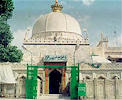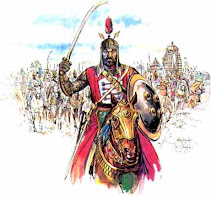South west of Jaipur, Ajmer is an oasis wrapped in the green hills. The city was founded by Raja Ajay Pal Chauhan in the 7th Century A.D. and continued to be a major centre of the Chauhan power till 1193 A.D. When Prithviraj Chauhan lost it to Mohammed Ghauri. Since then, Ajmer became home to many dynasties. Today, Ajmer is a popular pilgrimage centre for the Hindus as well as Muslims. Especially famous is the Dargah Sharif-tomb of the Sufi saint Khwaja Moinuddin Chisti, which is equally revered by the Hindus and Muslims. It is a centre of culture and education, the British chose Ajmer for its prestigious Mayo College a school exclusively for Indian nobility. Ajmer is also the base for visiting Pushkar (11 km.), the abode of Lord Brahma, lying to its west with a temple and a picturesque lake. The Pushkar Lake is a sacred spot for Hindus. During the month of Kartik (Oct. /Nov.), devotes throng in large numbers here to take a dip in the sacred lake.
Ajaipal Chauhan founded Ajmer in the seventh century. He constructed a hill fort "Ajaimeur" or the invincible hill. The Chauhans ruled Ajmer till the 12th century when Prithviraj Chauhan lost Mohammed Ghauri. Thereafter it became a part of the sultanate of Delhi. Ajmer was also favourite residence for the great Mughals. One of the first contacts between the Mughal King Jahangir and Sir Thomas Roe took place here in 1616. The Scindias took over the city in 1818 and then handed it over to the British and it became one of the only part of Rajasthan controlled directly by the East Indian Co.
Arhaidin Ka Jhonpra
Situated on the outskirts of Ajmer is Arhai-din-ka Jhonpra. It is considered to be the first Islamic structure to be built in India.
Tara Garh Fort
The fort was built by Ajaypal Chauhan in 1100 AD and gives a bird's eye view of the Ajmer city. It is also known as the Star Fort and is the first fort in India to be built on a hill. Ajaypal Chauhan originally named the fort as Ajai Meru as it was supposed to have become invincible.
Ana Sagar Lake
Located at a picturesque site to the north of Ajmer is Ana Sagar Lake, which was constructed by King Anaji, the grandfather of Prithvi Raj Chauhan. Later, Shahjahan added the marble pavilion to the lake. Daulat Bagh Gardens, created by Jehangir are located next to the lake.
Ajaipal Chauhan founded Ajmer in the seventh century. He constructed a hill fort "Ajaimeur" or the invincible hill. The Chauhans ruled Ajmer till the 12th century when Prithviraj Chauhan lost Mohammed Ghauri. Thereafter it became a part of the sultanate of Delhi. Ajmer was also favourite residence for the great Mughals. One of the first contacts between the Mughal King Jahangir and Sir Thomas Roe took place here in 1616. The Scindias took over the city in 1818 and then handed it over to the British and it became one of the only part of Rajasthan controlled directly by the East Indian Co.
Arhaidin Ka Jhonpra
Situated on the outskirts of Ajmer is Arhai-din-ka Jhonpra. It is considered to be the first Islamic structure to be built in India.
Tara Garh Fort
The fort was built by Ajaypal Chauhan in 1100 AD and gives a bird's eye view of the Ajmer city. It is also known as the Star Fort and is the first fort in India to be built on a hill. Ajaypal Chauhan originally named the fort as Ajai Meru as it was supposed to have become invincible.
Ana Sagar Lake
Located at a picturesque site to the north of Ajmer is Ana Sagar Lake, which was constructed by King Anaji, the grandfather of Prithvi Raj Chauhan. Later, Shahjahan added the marble pavilion to the lake. Daulat Bagh Gardens, created by Jehangir are located next to the lake.


















No comments:
Post a Comment